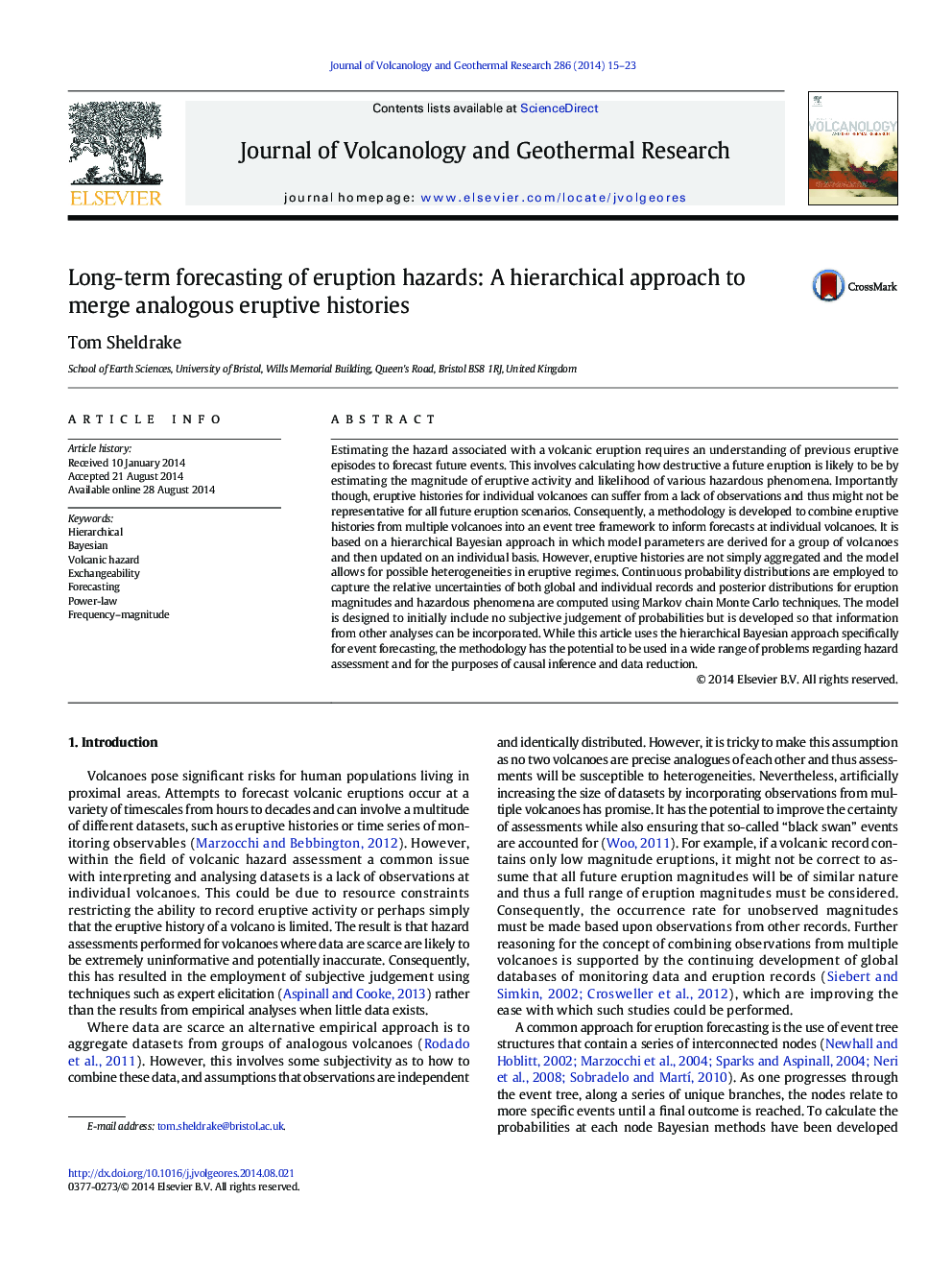| کد مقاله | کد نشریه | سال انتشار | مقاله انگلیسی | نسخه تمام متن |
|---|---|---|---|---|
| 6439652 | 1638336 | 2014 | 9 صفحه PDF | دانلود رایگان |
عنوان انگلیسی مقاله ISI
Long-term forecasting of eruption hazards: A hierarchical approach to merge analogous eruptive histories
ترجمه فارسی عنوان
پیش بینی طولانی مدت خطرات فوران: یک رویکرد سلسله مراتبی برای ادغام تاریخ های مشابه فوران
دانلود مقاله + سفارش ترجمه
دانلود مقاله ISI انگلیسی
رایگان برای ایرانیان
کلمات کلیدی
سلسله مراتبی بیزی، خطر آتشفشان قابلیت تعویض، پیش بینی، قانون قدرت، فرکانس بزرگ،
ترجمه چکیده
برآورد خطر همراه با فوران آتشفشان نیاز به درک قسمت های فوران قبلی برای پیش بینی وقایع آینده دارد. این شامل محاسبه فرسایش آینده فرسایش احتمالا با برآورد میزان فعالیت فوران و احتمال پدیده های خطرناک است. مهم است که هر چند، تاریخچه فوران برای آتشفشان های فردی می تواند از کمبود مشاهدات رنج ببرد و بنابراین ممکن است نماینده برای همه سناریوهای فوران آینده باشد. در نتیجه، یک روش شناسی برای ترکیب تاریخچه های فوران از چندین آتشفشان به یک چارچوب درخت رویداد برای پیش بینی در آتشفشان های فردی توسعه داده شده است. این بر اساس یک رویکرد سلسله مراتبی بیزی است که در آن پارامترهای مدل برای یک گروه از آتشفشان ها مشتق شده و سپس به صورت فردی به روز می شوند. با این حال، تاریخ فوران ها به سادگی جمع نمی شود و مدل اجازه می دهد تا ناهمگونی های احتمالی در رژیم های فوران. توزیع احتمالی مداوم برای ضبط عدم قطعیت نسبی هر دو پرونده جهانی و فرد و توزیع خلفی برای مقادیر انفجار و پدیده های خطرناک با استفاده از تکنیک های مونت کارلو زنجیره مارکوف محاسبه می شود. مدل طراحی شده است که در ابتدا هیچ قضاوت ذهنی از احتمالات را شامل نمی شود، بلکه توسعه یافته است تا اطلاعات از تجزیه و تحلیل های دیگر می تواند شامل شود. در حالی که این مقاله از رویکرد باینری سلسله مراتبی بویژه برای پیش بینی رویداد استفاده می کند، این روش می تواند در طیف گسترده ای از مشکلات مربوط به ارزیابی خطر و به منظور استنتاج علیت و کاهش داده ها مورد استفاده قرار گیرد.
موضوعات مرتبط
مهندسی و علوم پایه
علوم زمین و سیارات
ژئوشیمی و پترولوژی
چکیده انگلیسی
Estimating the hazard associated with a volcanic eruption requires an understanding of previous eruptive episodes to forecast future events. This involves calculating how destructive a future eruption is likely to be by estimating the magnitude of eruptive activity and likelihood of various hazardous phenomena. Importantly though, eruptive histories for individual volcanoes can suffer from a lack of observations and thus might not be representative for all future eruption scenarios. Consequently, a methodology is developed to combine eruptive histories from multiple volcanoes into an event tree framework to inform forecasts at individual volcanoes. It is based on a hierarchical Bayesian approach in which model parameters are derived for a group of volcanoes and then updated on an individual basis. However, eruptive histories are not simply aggregated and the model allows for possible heterogeneities in eruptive regimes. Continuous probability distributions are employed to capture the relative uncertainties of both global and individual records and posterior distributions for eruption magnitudes and hazardous phenomena are computed using Markov chain Monte Carlo techniques. The model is designed to initially include no subjective judgement of probabilities but is developed so that information from other analyses can be incorporated. While this article uses the hierarchical Bayesian approach specifically for event forecasting, the methodology has the potential to be used in a wide range of problems regarding hazard assessment and for the purposes of causal inference and data reduction.
ناشر
Database: Elsevier - ScienceDirect (ساینس دایرکت)
Journal: Journal of Volcanology and Geothermal Research - Volume 286, 1 October 2014, Pages 15-23
Journal: Journal of Volcanology and Geothermal Research - Volume 286, 1 October 2014, Pages 15-23
نویسندگان
Tom Sheldrake,
